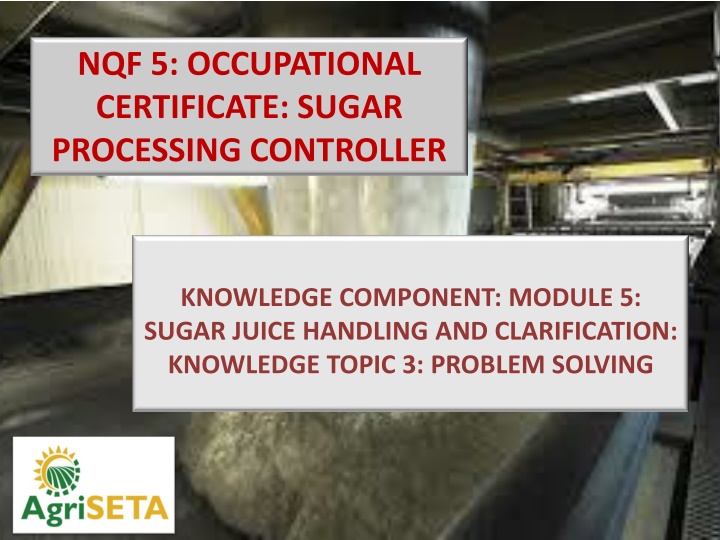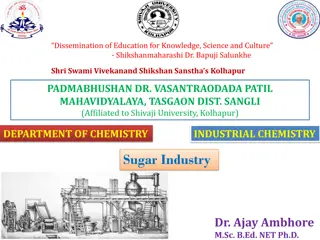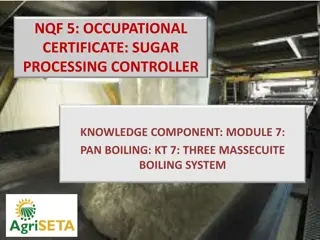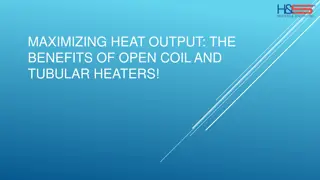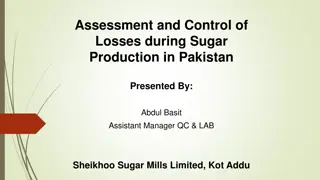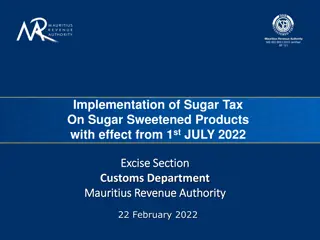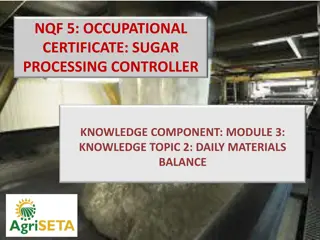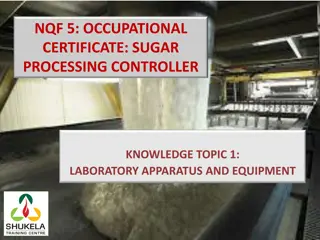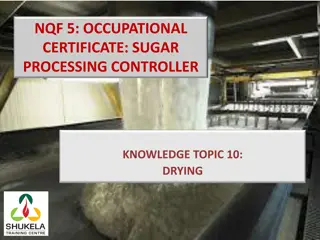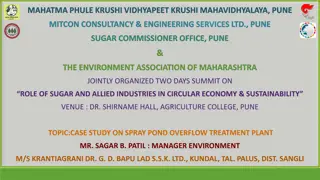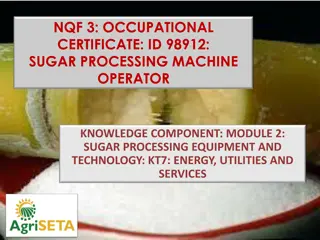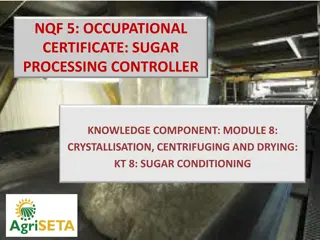Sugar Processing Controller - Heating and Liming Problem Solving
This content delves into various heating and liming problems encountered in sugar processing control, providing insights on corrective measures. Topics covered include heating purposes, temperature ranges, liming issues, pH control, indicator usage, lime concentration estimation, sucrose inversion factors, and optimal pH conditions for clear juice.
Download Presentation

Please find below an Image/Link to download the presentation.
The content on the website is provided AS IS for your information and personal use only. It may not be sold, licensed, or shared on other websites without obtaining consent from the author.If you encounter any issues during the download, it is possible that the publisher has removed the file from their server.
You are allowed to download the files provided on this website for personal or commercial use, subject to the condition that they are used lawfully. All files are the property of their respective owners.
The content on the website is provided AS IS for your information and personal use only. It may not be sold, licensed, or shared on other websites without obtaining consent from the author.
E N D
Presentation Transcript
NQF 5: OCCUPATIONAL CERTIFICATE: SUGAR PROCESSING CONTROLLER KNOWLEDGE COMPONENT: MODULE 5: SUGAR JUICE HANDLING AND CLARIFICATION: KNOWLEDGE TOPIC 3: PROBLEM SOLVING
Heating Problems and Corrective Measures The purpose of heating: Promotes coagulation of proteins Increases the rate of the precipitation Removes air by flashing Controls microbiological losses Facilitates sucrose extraction Heating is done between 65 C to 90 C in the first stage and 90 C to 105 C in the second stage Above 105 C melted waxes emulsify and become difficult to remove The velocity of the juice through the heater tubes should lie between 1.5 to 1.8m.s-1 to: Get good turbulence and heat transfer To reduce incidence of scaling To reduce heating surface (smaller heaters are then possible)
Liming Problems and Corrective Measures At the milk of lime plant, there are three buffer tanks, where a supply of milk of lime is kept The milk of lime is continuously added to the hot juice in the perry tank, pH being controlled automatically pH and the temperature must be kept constant to obtain maximum purification If the pH controller fails to control: It must be switched to manual Lime dosing is controlled manually with the aid of indicator paper Will turn a shade green for the correct pH If the colour turns yellowish, more lime must be added Also used for manual pH control are Phenol red and bromothymol blue These indicators change colour at approximately pH 7 Colour change is from yellow (acid) to red (alkaline) for phenol red Colour change is from yellow (acid) to blue (alkaline) for bromothymol blue
Liming Problems and Corrective Measures cont. Use a Beaume Spindle for rough estimation of lime concentration If the clear juice is heated at a pH below 7, sucrose will be hydrolysed and form invert sugar Sucrose inverted depends on: The pH (more sugar is inverted at a lower pH) The temperature (the reaction is speeded up, when the temperature is higher) The time At higher pH values: The reducing sugars will form coloured bodies and acids, These cause many troubles in the production of white sugar It has been found that keeping the clear juice at about pH 7.2 is the optimal pH
Clarification Problems and Corrective Measures For proper clarification the following points should be kept in mind: An alkaline reaction causes: Destruction of reducing sugars Coloured products are formed Increased viscosity in massecuites and molasses, causing: Poor curing Lower exhaustion Negatively affects the quality of the sugar An acid reaction causes inversion of sucrose Higher temperature speeds up the two reactions above Short retention times are desirable, as the reactions above are time dependent
Clarification Problems and Corrective Measures (cont.) Filling and emptying the clarifier is critical and should be done slowly Bypass gate must be fully open Before starting the juice feed, start the scraper mechanism Fill from the bottom up Mud pump must be started soon after the juice starts flowing into the clarifier To empty: The centre tube bypass valve must be opened and the unit emptied slowly Once empty the clarifier must be thoroughly washed out with water
Clarification Problems and Corrective Measures (cont.) If the top compartment overflows pump mud out faster Lower compartment overflows raise the overflow sleeve If all compartments overflow Pump mud out faster Slow down the feed rate The settling properties of the floc may have changed. Check: pH Juice quality Temperature No juice flow from lower compartments Feed might be below capacity Mud removal is too fast (thin mud). Slow down the pumping rate. Overflow pipe may be blocked. Clear blockage The juice in overflow pipe may have cooled which will raise its density. Lower the sleeve to regain flow, then raise to original position again. Or use an air or steam line in the juice pipe to lift the juice
Clarification Problems and Corrective Measures (cont.) Mud is thin Removal of mud is too fast Slow down pumping rate Clarifier may be overloaded and does not have enough time to thicken Slow down the feed rate Unable to pump mud Mud may be too thick Flush the pipe with water and pump out faster Pump may not be working Check and correct Pipe may be blocked Try flushing with air and water
SRI Clarification Problems and Corrective Measures Flocculant dosing rates: Periodic settling tests should be done to ensure correct dosage rate Flocculant must be distributed evenly Check: Adjustment of flowmeters Strength of flocculant Pump operation Flocculant tank has flocculant in it Lumps in flocculant Right pH. Check the pH control system and dosing device
SRI Clarification Problems and Corrective Measures (cont.) Juice temperature entering the clarifier must be at least 100 C. Foam on the feed launder is an indication of air entrainment and poor flashing. It is critical that the rate of feed to the clarifier not exceeds the settling rate. If the settling rate of the juice reduces, the action is taken in the following order. Add more flocculant or change the flocculant Add phosphoric acid to produce more precipitate Reduce the mixed juice flow rate by slowing down the mill
Juice Deterioration Effect of pH Purity drip increases as pH falls below 7.2 at a temperature of 88 C over a 40-hour storage period If a longer storage period is expected, the pH must be increased Effect of temperature Minimum purity drop between 71 and 74 C. Below this microbial activity increases drop in purity Above this temperature chemical decomposition increases inversion increases Control deterioration as follows: Cold storage: Maintain a juice temperature below 71 C and treat the juice with a bactericide like formalin Hot storage: Maintain a juice temperature above 75 C and increase the pH by adding more lime Keep mud levels as low as possible during shut-down periods During weekend or emergency shut-down liquidate the clarifier if possible
Clear Juice Quality If clear juice quality is poor, check: Juice flow Increased juice flow causes disturbances in the clarifier If the juice flow is steady check the pH and temperature Check on the brix of the incoming mixed juice Incomplete settling may be due to: Small size of particles Protective colloid action Density of some particles not greater than that of the liquid Slow settling may be due to: Viscosity of the liquid Large surface area of particles Small density difference between particles and liquid
Clear Juice Quality (cont.) Large volume of settlings may be due to Large amount of precipitable material, particulary phosphate Low density of settlings Low density settlings may be due to: Shape and size of particles Hydration of the particles
Filtration Problems and Corrective Measures The criteria of a good filter operation are: Good retention, depending on: Properly adjusted distribution head No worn or broken screens The bagacillo ratio: The ratio between bagacillo and mud should be +/- 0.6 to 1. Bagacillo fineness Approximately 80% dried bagacillo should pass a 20 mesh screen. Rpm of the rotating drum High and low vacuum Low pol % filter cake, depending on: Amount of water Proper distribution and spraying of wash water covering the whole surface of the drum Temperature of the wash water should be approximately 90 C Rpm of the rotating drum High and low vacuum, of which the ratio should be 2:1 with an optimum high vacuum of 50kPa
Mud Retention Problems and Corrective Measures Bagacillo quality: Must be fine (mostly pith) Free of long fibre Should pass through a 0.8mm screen (90%) and a 0.5mm screen (70%). Bagacillo quantity: Dry bagacillo % feed - 3% More than 3% - mixing and pumping is difficult, and Wash water causes channeling with resultant poor washing Mud solids concentration (MSC): With a low MSC (thin mud) a lot of filtrate passes through the filter screen before the filtering mat is formed - causing poor retention. With a MSC of 3% or less poor retention With a MSC of 3%-4% higher retentions are possible provided the bagacillo ratio is correct. More bagacillo is required as the concentration of mud solids increase
Mud Retention Problems and Corrective Measures (cont.) Pickup vacuum: A low pickup vacuum allows the cake to build up gradually and form a porous cake that allows for effective washing The pickup vacuum should not exceed - 20 kPa. A high pickup vacuum results in cloudy filtrate due to the solids being sucked through the screen. Filter speed: Speed of the filter drum influences the formation of the cake Maximum speed should be 1 revolution in 6 minutes Faster will reduce the retention Optimal speed will give the wash water sufficient time to displace the juice
Cake Washing Problems and Corrective Measures Wash water temperature: A low wash water temperature (below 70 C) reduces efficiency because of the solidification of waxes These waxes solidify behind the screen and the screen and the wash water has difficulty in draining away A too high water temperature can cause flashing at the filtrate pump Pick up vacuum: A low pick-up vacuum results in a porous cake with good washing properties. The pick-up vacuum must be less than -20 kPa gauge Dry bagacillo % feed: If the dry bagacillo % feed exceeds 4% channeling of the cake will result which will reduce the washing efficiency Filter speed: Low/slow filter speeds give the cake more exposure to the wash water which will improve the washing efficiency
Cake Washing Problems and Corrective Measures (cont.) High vacuum: A good vacuum (at least -60 kPa gauge) will draw water through the cake with a greater force - thus improving efficiency If the vacuum is too high (about -80 kPa gauge) there will be a possibility of flashing at the filtrate pump Bagacillo quality: Fine bagacillo gives a cake through which the wash water will be easily drawn The water will not run off but go through the cake and improve the removal of pol Spray nozzles: Blocked nozzles stop the flow of water with no washing of the cake Partially blocked nozzles cause the wash water to squirt out with considerable force This results in channeling, excessive washing of part of the cake and dilution of filtrate Nozzles should be checked regularly and cleaned whenever necessary
Filtration Further Problems and Corrective Measures Filter feed temperature should not be less than 85 C after bagacillo addition. Screen blinding may occur at lower temperatures through solidification of waxes. The addition of feed to the filter trough should be continuous and proportional to the filtration rate. The mud level in the filter trough mud boot should be constant and evenly distributed over the length of the filter. Mud overflow into the overflow tank should be avoided and if it does occur the mud should be pumped back immediately to avoid cooling and fermentation. The addition of flocculant at 4 - 5ppm can sometimes help filtration but is not essential. The cake thickness will vary with filter speed. The thickness can be increased by slowing the filter and by increasing the bagacillo ratio. At the normal speed of 10 - 15 revs per hour the cake should be 5 - 6 mm thick. A thin cake will result in poor retention and blinding. The pH of the feed should be adjusted after the clarifier to about 7.5 with milk of lime.
Sucrose losses Corrective Measures Sucrose losses in the filter cake are between 0.2 and 0.3% of the sucrose in cane Acceptable Sucrose losses in the filter station due to microbial activity is not acceptable Associated with Low temperatures Long filtrate residence times in the filter station (should be 14 to 46 minutes) Corrective measures: Reduce the heat loss which results from long retention times Increase wash-water temperatures to at least 80 C Reduce the heat loss caused by poor distribution and circulation of filter feed in the filter boots (check for dead spots ) modify feed piping and use steam sprayers in the boot Increase filtration rate, to reduce number of filters thus reduce filtrate retention time Check mud pH An indication of deterioration in the clarifier (Should be higher than clear juice pH because of the lime particles.)
